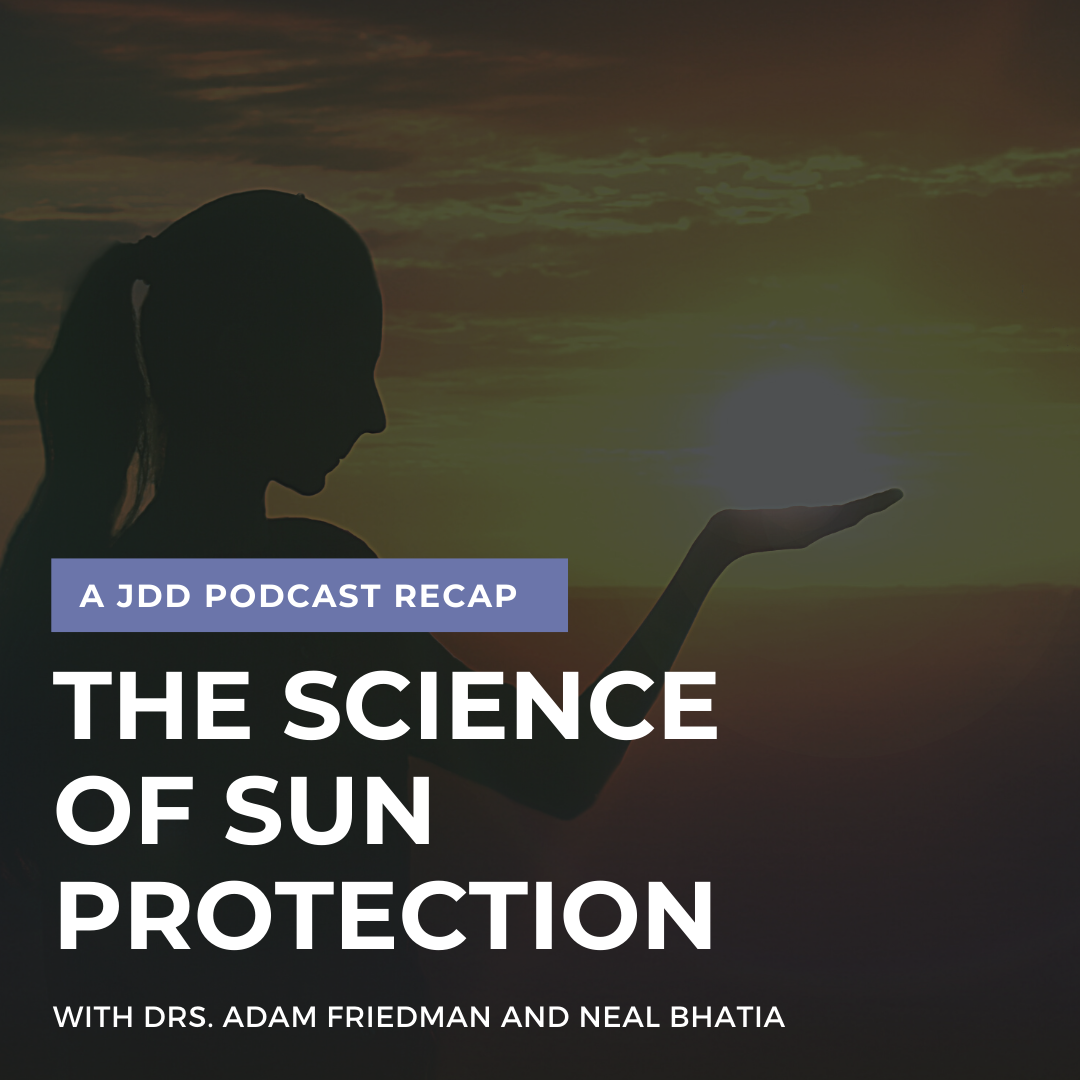A patient in my clinic was recently prescribed 5-fluorouracil for severe photodamage, diffuse actinic keratoses. He is 24 years old and, unfortunately, lacked knowledge about photoprotection. It was sobering to think about how much longer he has to live and the damage already done. Strides have been made over the years in educating our patients about photoprotection, but recently, patients have begun to express concern about these necessary preventative products.
Luckily, a recent JDD dermatology podcast has provided us with helpful tactics and information for use when educating our patients on photoprotection. In their discussion, Dr. Neal Bhatia and Dr. Adam Friedman, share their anecdotes and thoughts about the photoprotection landscape. You can hear the dermatology podcast for yourself here.
This article will provide an overview of the podcast, including:
-
- Barriers to sunscreen use such as: use with other topicals (“layering”), issues with make-up, difficulty with creating a routine for consistent use, delayed gratification, school restrictions, coral reefs, systemic absorption, and vitamin D
- Brief discussion of notable articles: coral reef effects and systemic absorption of organic sunscreens
- Tips on how to discuss sunscreens with patients
- Future directions for photoprotection
Before we get into the full review, here are my “practice barometers” – what I took away from the podcast that may change my practice or confirm my standards:
 Continue to discuss sun protection with every patient as it has wide preventative effects for skin cancer, dyschromia, wrinkles, etc. I typically work this in during the exam. (Want to know tips for patient education? Keep reading!)
Continue to discuss sun protection with every patient as it has wide preventative effects for skin cancer, dyschromia, wrinkles, etc. I typically work this in during the exam. (Want to know tips for patient education? Keep reading!)
 The media can shift our patients’ views of sun protection, almost to the point of brainwashing – get educated so you can speak intelligently about coral reef damage and systemic uptake of sunblock. (What do the studies show? Look below!
The media can shift our patients’ views of sun protection, almost to the point of brainwashing – get educated so you can speak intelligently about coral reef damage and systemic uptake of sunblock. (What do the studies show? Look below!
 I should ask patients about what barriers they perceive to using sunblock. (How can we alleviate those barriers? Let’s see!)
I should ask patients about what barriers they perceive to using sunblock. (How can we alleviate those barriers? Let’s see!)
 I love patient handouts (my staff is all sighing) and will continue handing these out and refining them. (Consider checking out the AAD website, the ASDS website, and other dermatology resources, for patient handouts or ordering their pamphlets, which is another great resource.)
I love patient handouts (my staff is all sighing) and will continue handing these out and refining them. (Consider checking out the AAD website, the ASDS website, and other dermatology resources, for patient handouts or ordering their pamphlets, which is another great resource.)
What are the benefits and limits of chemical and physical sun-blocking products?
-
- Sunscreen and sunblock are critical for the maintenance and prevention of common skin issues – dyschromia, wrinkles, scars, skin cancers, thinning of the skin, and the list goes on
- Chemical (organic) sunscreens absorb UV energy – UV radiation energy excites the electrons of the chemical filter, which is given off as thermal energy as the electrons come back down to resting state. Over time, the ability of the chemical sunscreen to become “excited” and return to base state decreases with continued exposure
- Chemical sunscreens are more likely to be irritating to the skin
- Physical blockers reflect light and are typically less irritating, but can come with a white film or paste unless micronized or tinted
- Organic (chemical sunscreen) vs mineral (sunblock) – combination of both is ideal as it maximizes both aspects and can be more elegant
- Look for products with multiple but smaller concentrations as they can work in concert and have a synergistic effect – also decreases the likelihood of irritation given less concentration of each product
What are the barriers for patients in regular use of sun protection?
-
- The need for “layering” such as moisturizers, make-up, and SPF. How does the SPF work with the patient’s makeup? Does the patient’s school allow them to carry sunscreen?
- Routines can be difficult to create. And there may be no perceived immediate gains.
- Vitamin D and sunscreen use. We know that UVB leads to Vitamin D2. How many times have you heard patients say “but I need my vitamin D”?
- Using sunscreen is “having to do one more thing”
- Sunscreen’s impact on coral reefs – Are they real?
- What about hormone effects of sunscreens? Do sunscreens cause cancer?
- Systemic uptake of UV filters? Are there negative health effects?
What are effective clinician-patient discussions that motivate patients to integrate regular use of sunscreens in their skin care regimen?
-
- “Sunscreen is like toothpaste” – it is a means for preventing problems!
- Highlight the investment! – This helps you look younger/better and reduce skin cancer risk
- When patients say “I don’t go in the sun” – What about the walk to the clinic, to the grocery store, etc.?
- Vitamin D? A well-balanced diet and/or supplements are all that is needed. Check out the AAD position statement from the academy website or here. Bhatia will provide this to his patients if Vitamin D is a concern
- There are studies that show that high concentrations of certain UV filters (namely Oxybenzone and Octinoxate) can negatively affect coral reefs and lead to bleaching. But the concentrations studied are not known to be present at coral reefs. “Correlation does not equal causation”.
- As far as carcinogenic and estrogenic effects of UV filters, the basis of these claims seems to stem from a particular study with two arms:
- In vitro breast cancer cell cultures bathed in UV filters showed proliferation and,
- In vivo rat models were fed UV filters and showed estrogen effects via increased uterine weight. Again, correlation (which is pretty thin here) does not equal causation.
- In a JAMA study, systemic levels of 4 (avobenzone, oxybenzone, octocrylene, and ecamsule) UV filters were assessed after application to 75% of the body surface area at 2mg per 1cm2. It showed detectable levels above that which the FDA requires further study of health effects. I think it is important to remember this quote from the paper:
They are absorbed at very low levels, and we don’t know what this means yet. But we do know UV rays create cancer!
What multifunctional approaches exist?
-
- Consider combination products such as those that are SPF in moisturizer or SPF in a foundation (whether liquid or powder)
- Polypodium leucotomos extract – and similar products or compounds – not to be used instead of sunscreen but can aid in a sun protection program. (I take two 240mg tabs before heading to the beach – but I use reapplied sunblock, hats, and a long sleeve rash guard as well)
- Sunscreen additives such as antioxidants and photolyases (enzymes that can repair UV-induced DNA damage)
- Future directions and research may deliver additives to sunscreens that may lead to reparative effects and better combinations with cleansers, retinoids, moisturizers, etc.
Other important facts discussed
-
- No new sun filter in the past 20 years
- It’s okay to supplement Vitamin D – especially if that leads to a patient being more likely to use sun protection
- SPF in moisturizer may be good for limited sun exposure but are likely not enough if someone is to be outside for a longer period of time – use a sunscreen only product
- If you have had skin cancer or pre-cancers consider increasing SPF – if you are using 30, go to 50 or higher
- Combination of UV filters and/or minerals can be synergistic!
- Ensure your office staff are also capable of having a discussion with patients about sun protection
- We still need further developments in the area of sunblock for skin of color – including formulations with newer vehicles, micronized products, tints that are elegant, etc.
Final Thoughts
-
- Should we be using “scared straight” tactics to encourage patients to use sunblock? Such as images of skin cancer surgery. What about a “slip, slap, slop” type campaign that Australia has utilized?
- Incorrect social messages (ex: vitamin D, coral reefs, systemic uptake) need to be countered with common sense
- Get back to the fundamentals – when to apply, why to apply, how often to apply
- Consider giving patients information to go home with after their appointment
Look out for a recap of the second part in this series – Understanding and Changing Patient Behavior and Minimizing Risk of UV Damage coming up on Next Steps soon.
How do you approach a discussion with patients about sun protection? Please share your comments and join the discussion at the end of this post, and on Instagram @nextstepsinderm!
Dr. Neal Bhatia is the Director of Clinical Dermatology at Therapeutics Clinical Research in San Diego, CA.
Dr. Adam Friedman is the Interim Chair of Dermatology and serves as Residency Program Director, Director of Translational Research, and Director of the Supportive Oncodermatology Program in the Department of Dermatology at The George Washington University School of Medicine & Health Sciences
This information was presented by Dr. Neal Bhatia and Dr. Adam Friedman during a JDD Dermatology Podcast on September 10th, 2020. The above highlights from their discussion were written and compiled by Dr. James Contestable, staff dermatologist at Naval Medical Center Camp Lejeune.
Did you enjoy this JDD Dermatology Podcast Recap? You can find more here.

